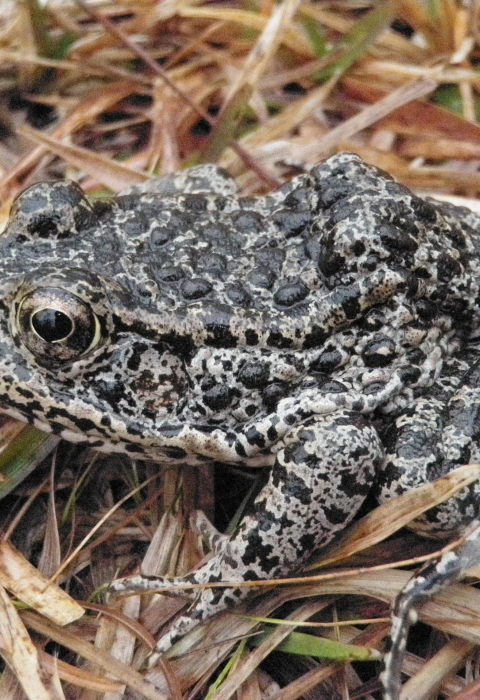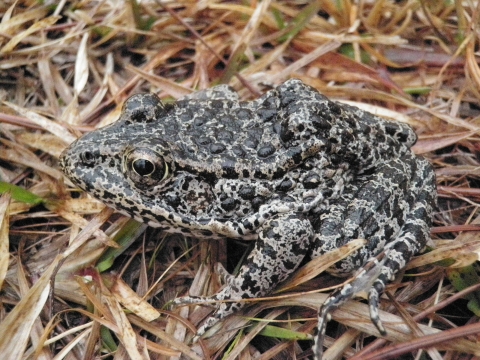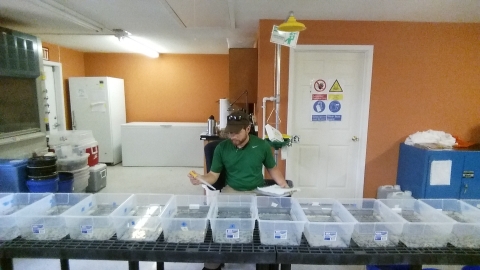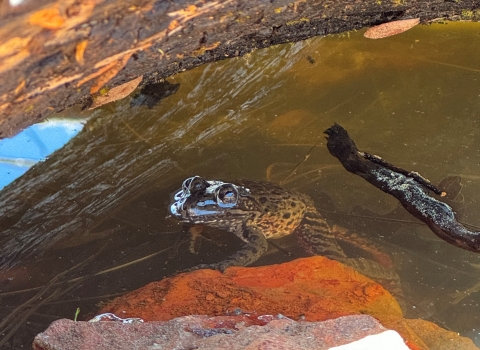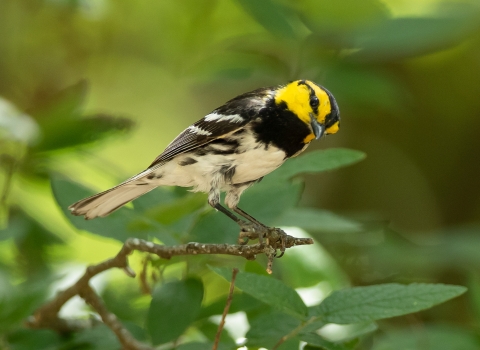When biologist John Tupy started his job at Western Carolina University in 2008, he had no idea the big influence a little hopper would have on his life.
A graduate student, Tupy was sent to southern Mississippi where he encountered a spotted, bumpy amphibian -- the dusky gopher frog. The meeting led to a career for Tupy, now a biologist with the U.S. Fish and Wildlife Service.
Listed as an endangered species in 2001, the Service monitors its population and reviews its status at least once every five years. These status reviews help determine where a species stands on its road to recovery.
The latest status review was released in May 2021: The species is still considered endangered, but biologists see reason for hope.
Among the optimists is Tupy, who discovered an affinity for the frog he met in Mississippi all those years ago.
“I’ve always liked reptiles and amphibians, but this frog just seemed... unique,” says Tupy.
Unique indeed. Unlike most frogs, dusky gopher frogs spend the majority of their lives in underground refugia in uplands and away from wetlands. Only the allure of the opposite sex lures them out.
When breeding season rolls around, the frogs hop to ephemeral ponds – temporary bodies of water that exist only for a few weeks or months. These ponds play a huge role in the lifecycle of the dusky gopher frog since they provide just the right environment for an egg to become a tadpole and the tadpole to become a frog.
But as years passed, those ponds proved too ephemeral. As they vanished from the landscape, so did the frog.
‘One guy’
From the little pond, a low, snoring sound emanated. Not a creature asleep, but something very much awake and looking for love: a male dusky gopher frog. Glen Johnson was there to hear it.
In the world of biology, this was a big deal. In the 1980s, the Mississippi Museum of Natural Science had released a list of amphibians and reptiles that had not been seen for years in the state. The inventory included Rana sevosa, the dusky gopher frog.
A lab technician with the U.S. Forest Service and an enthusiastic amateur herpetologist, Johnson decided to try his luck at finding any of the bumpy, spotted frogs. In his rambles around DeSoto National Forest, he’d located three ephemeral ponds that looked like suitable breeding environments. At one, he heard that lone frog. When he announced his discovery in 1988, biologists hurried to document his find.
“It was a lucky chance that Mr. Johnson came along and found this pond,” Tupy says. “This one guy may have very well saved the species.”
The Service also recognized that the frog had the best chance of surviving if it had more habitat. Scientists roamed Forest Service land near the original pond where Johnson discovered the frog, looking for potential sites to restore breeding habitat. Their goal was simple, if a bit audacious: to turn back the clock to restore ponds to their natural state from over a century ago.
Restoration efforts began in the early 2000s. Forest Service partners cleared hardwood trees and overgrowth to restore ponds to their more natural, fire-maintained, open-canopy state. They also created a new pond and deepened some existing ponds. The real challenge: getting water to the ponds. The ephemeral ponds need rain. Not trusting nature to cooperate, biologists at first tried pumping well water into one of the ponds.
But the best-laid plans of biologists don’t always work out.
The little frog is plagued by a novel disease whose spores rest in dry pond basins waiting for rainwater. As the ponds fill, the spores release and proliferate. The disease settles in the tadpoles’ guts, ruptures, and kills the tadpoles before they undergo metamorphosis into frogs. Water acidity level, or pH, is a factor in spore development. The higher the pH, the more spores will proliferate.
Well water, biologists discovered, was an elixir for spores with high pH levels. They searched for different ways to help the frog. When they learned of research work involving raising amphibians in cattle watering tanks, the biologists crossed their fingers. Maybe this was the key?
In 2002, Service biologists acquired some of these tanks, created microenvironments similar to natural breeding sites, and held their collective breath. The tanks were successful – timely, too. For 10 consecutive years, the lone breeding pond had failed to hold water long enough for tadpoles to metamorphose. The cattle tanks kept the species alive, allowing biologists to collect egg masses, raise the tadpoles, and release them into the wild.
Timely solution
That was the scene that greeted Tupy when he came to Mississippi. The tank-raised young were beginning to return to the pond to breed.
“I think if it wasn’t for the cattle tanks, that population would have gone extinct too,” he says.
Things have improved since then. The 10-year drought was followed by five years of good, frog-breeding rain. In one year, almost 1000 metamorphosed frogs emerged from the breeding pond.
“Some of those human interventions did work,” says Tupy. “It allowed the pond to reach suitable conditions that enabled the frog to naturally do what it had been trying to do for the last 10 years.”
Scientists also knew they were running a risk with all their eggs in one figurative basket. Suppose something catastrophic happened to the pond and wiped out the entire population? The frogs needed multiple ponds in close proximity so they could hop from one to the next.
Biologists got busy. The Service, in collaboration with the Forest Service and the Mississippi Department of Wildlife, Fisheries, and Parks, identified three locations within migrating distance of the main pond and created the proper habitat for tadpoles to grow. They hoped some adult frogs from the main pond would migrate and establish themselves in the new sites. This would spread out the population and enhance the odds of creating a viable population.
Their work paid off. Dusky gopher frogs, in 2013 and again in 2016, bred in two of the three new ponds.
The Service hasn’t stopped at three ponds. There are now seven translocation sites throughout southern Mississippi where the frogs have been relocated. The main pond, the source for all the translocated animals, is still stable.
“I think we’re at a much better place than where we were five years ago, or even 10 years ago,” says Tupy. “We still have a lot of concerns about the disease, but the progress we’ve made with the translocations has been phenomenal.”
Fifteen years after starting work on the species, Tupy sounds as enthusiastic about the dusky gopher frog now as he did when a university in the mountains of North Carolina sent him to the coastal plain of Mississippi.
Tupy’s hope for recovery of the species is bolstered by the species protection under the Endangered Species Act (ESA).
Since being passed 50 years ago, the ESA has proven that it is extraordinarily effective at preventing species from going extinct. More than 99 percent of all species listed under the law are still with us today. Tupy is optimistic the dusky gopher frog will continue to be part of this 99 percent.
The ESA also inspires diverse partnerships to prevent species extinctions and recover listed species. This is more than evident by the collaborative conservation work being done to support the dusky gopher frog.
“We have so many good partners involved that want to keep moving towards recovering the species,” says Tupy. “We're not ready to stop. We want to keep building on this success. We want to make sure this frog is fully recovered before we take our foot off the gas."
